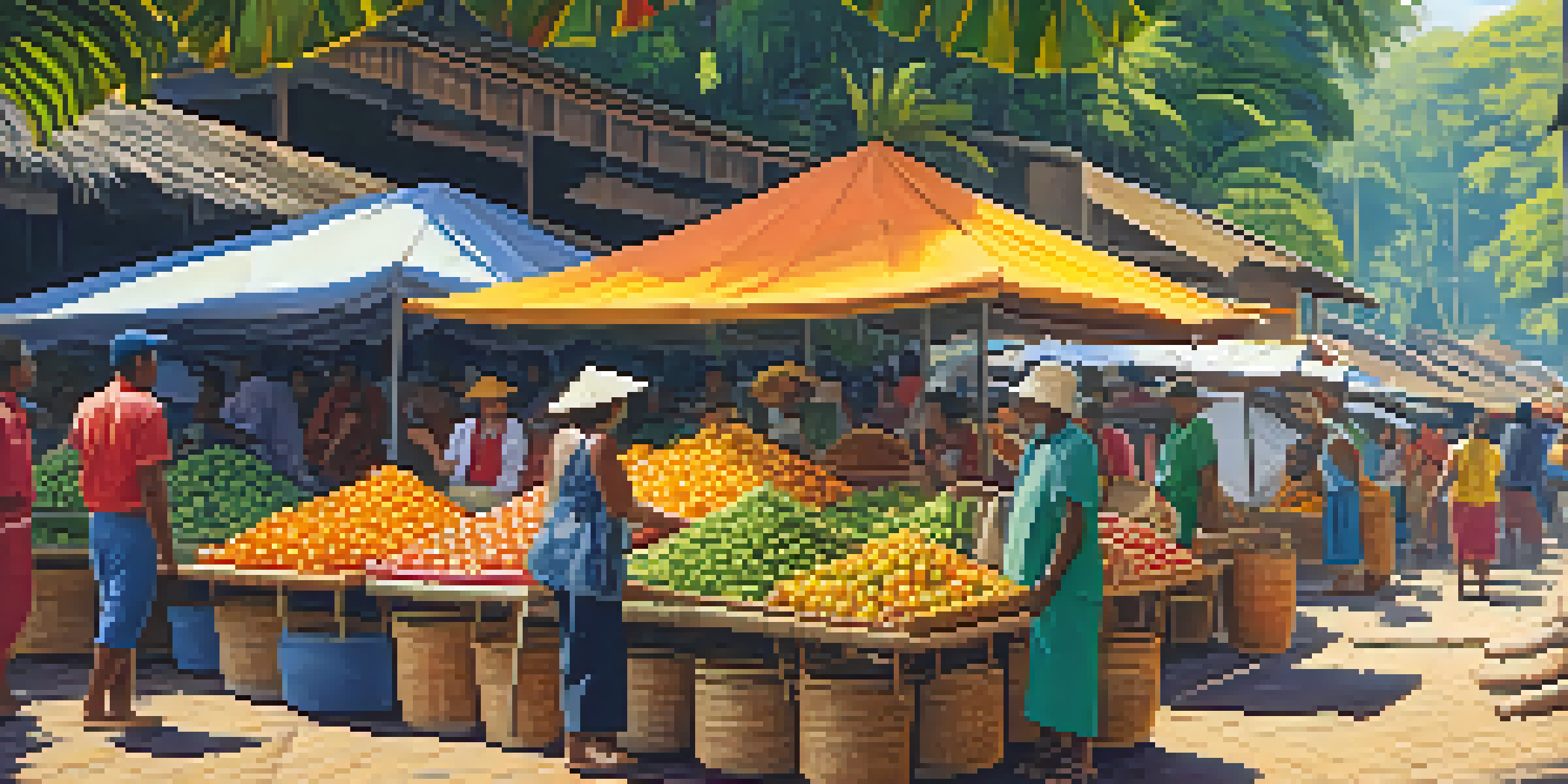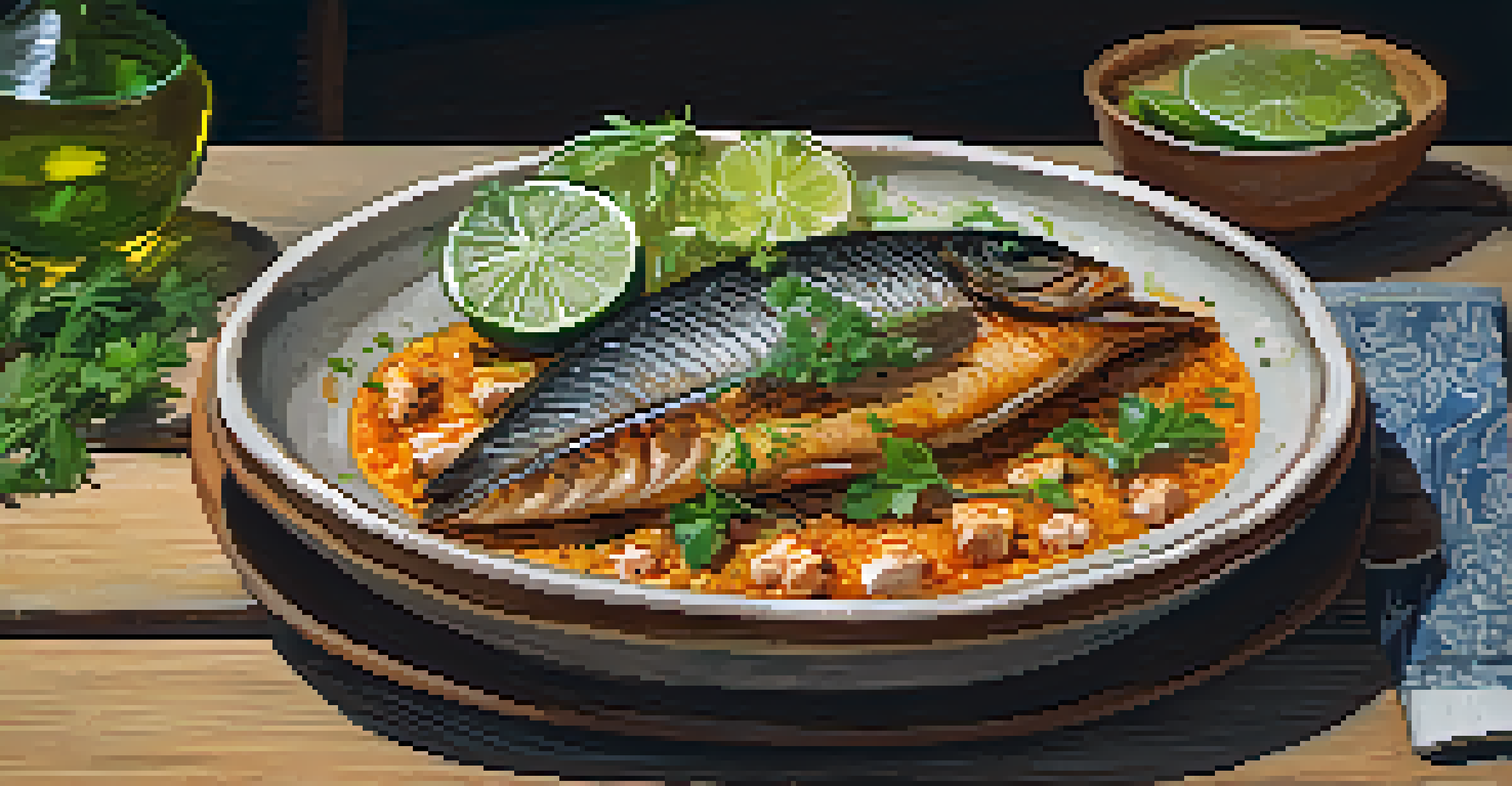Discovering the Unique Flavors of Brazilian Amazonian Cuisine

Introduction to Amazonian Cuisine: A Culinary Journey
Amazonian cuisine is a vibrant tapestry woven from the rich biodiversity of the region and the traditions of its indigenous peoples. From tropical fruits to unique fish, every ingredient tells a story that reflects the culture and environment of the Amazon. As we embark on this culinary journey, we'll discover how the flavors of the rainforest come together to create dishes that are both nourishing and delicious.
Food is our common ground, a universal experience.
The cuisine is not just about taste; it’s deeply intertwined with the land and the people who inhabit it. Traditional cooking methods often involve smoking, roasting, and using clay pots, which infuse the food with distinctive flavors. By exploring these techniques, we gain a better appreciation of how Amazonian cuisine has evolved while remaining rooted in its ancestral practices.
Moreover, the Amazon is home to an array of ingredients that are often overlooked in mainstream cooking. The combination of indigenous knowledge and local resources has led to the development of unique dishes that highlight the region's natural bounty. As we delve deeper, we'll celebrate the fusion of flavors that make Amazonian cuisine truly exceptional.
Key Ingredients: The Heart of Amazonian Dishes
At the core of Amazonian cuisine lie an array of key ingredients that are both exotic and flavorful. Ingredients like açaí, tucumã, and jambu are staples that offer unique flavors and textures. For instance, açaí berries are not only a superfood but also lend a delightful tartness that enhances smoothies and bowls, making them popular both locally and globally.

Fish, particularly from the mighty Amazon River, plays a crucial role in the diet of the region. Varieties like tambaqui and pirarucu are often featured in traditional dishes, showcasing how local fishermen contribute to the culinary landscape. These fish are typically prepared in ways that preserve their natural flavors, such as grilling or stewing with aromatic herbs.
Diverse Ingredients Define Amazonian Cuisine
Amazonian cuisine features unique ingredients like açaí, tucumã, and local fish that reflect the region's biodiversity and cultural heritage.
Additionally, the Amazon rainforest provides a bounty of fruits and nuts that are integral to the cuisine. From Brazil nuts to tropical fruits like cupuaçu, these ingredients add not only flavor but also nutritional value to dishes. The use of these ingredients illustrates a deep connection between the people and their environment, celebrating the gifts of the rainforest.
Traditional Dishes: A Taste of the Amazon
When it comes to traditional Amazonian dishes, few can match the popularity of 'tambaqui na brasa,' or grilled tambaqui. This dish showcases the fish's rich, flaky texture and is often served with sides like farofa, a toasted cassava flour mixture. The dish is a celebration of local fishing traditions and is enjoyed by families during gatherings, making it a cherished part of Amazonian culture.
The discovery of a new dish does more for the happiness of mankind than the discovery of a star.
Another iconic dish is 'maniçoba,' a stew made from the leaves of the manioc plant. When prepared correctly, it becomes a hearty dish that’s full of flavor, often enjoyed with rice and meat. This dish highlights the ingenuity of using local ingredients to create comforting food that warms the soul, especially during communal feasts.
Then there’s 'pato no tucupi,' which combines duck with a yellow sauce made from tucupi, a traditional broth derived from wild manioc. This dish represents the perfect balance of flavors and is a testament to the culinary creativity found in the Amazon. Each bite not only satisfies the palate but also tells a story of the land and its people.
The Role of Indigenous Knowledge in Cooking
Indigenous communities in the Amazon have been custodians of culinary knowledge for centuries, and their traditional practices play a pivotal role in shaping the region's cuisine. They possess an intimate understanding of local flora and fauna, which allows them to utilize ingredients in ways that maximize flavor and nutrition. This wisdom is often passed down through generations, ensuring that the essence of Amazonian cooking remains alive.
Cooking methods among indigenous peoples are often sustainable and deeply respectful of nature. Techniques like roasting over open fires or using clay pots not only enhance flavors but also reflect a commitment to preserving the environment. By embracing these methods, modern cooks can honor tradition while innovating in the kitchen, creating a bridge between past and present.
Culinary Traditions and Community Bonds
Food plays a vital role in Amazonian culture, fostering community ties and preserving traditions through shared meals and storytelling.
Moreover, the integration of indigenous ingredients into mainstream cuisine is gaining momentum, with chefs and home cooks alike exploring these unique flavors. This not only elevates Amazonian cuisine but also fosters a greater appreciation for the culture and history behind each dish. As we discover these culinary practices, we gain insights into the rich tapestry of Amazonian life.
Modern Innovations: Contemporary Takes on Classic Flavors
In recent years, chefs have begun to reinterpret Amazonian dishes, infusing them with modern techniques and global influences. This culinary renaissance has led to the emergence of restaurants that celebrate Amazonian ingredients while offering a fresh perspective on traditional recipes. By doing so, they are captivating a new generation of food lovers eager to explore these unique flavors.
For example, açaí bowls have become a trendy superfood item around the world, but their roots lie deep in Amazonian culture. Chefs are now experimenting with these ingredients, creating visually stunning dishes that not only taste great but also tell the story of their origin. This fusion of old and new showcases the versatility of Amazonian cuisine and its potential for global appeal.
Additionally, the use of innovative cooking techniques, such as molecular gastronomy, is bringing a fresh twist to classic Amazonian flavors. This approach allows chefs to deconstruct traditional dishes and reassemble them in unexpected ways, surprising diners and inviting them to rethink what they know about Amazonian food. The result is a vibrant culinary landscape that honors its roots while embracing contemporary creativity.
The Cultural Significance of Food in the Amazon
Food in the Amazon goes beyond mere sustenance; it is a vital part of cultural identity and community bonding. Traditional meals often serve as the backdrop for gatherings, celebrations, and rituals, reinforcing social ties among families and friends. This communal aspect of dining fosters a sense of belonging, echoing the importance of food in many cultures around the world.
Moreover, the preparation and sharing of meals often involve storytelling, where elders pass down wisdom and traditions to younger generations. These moments create a rich tapestry of shared experiences that connect people to their heritage. In the Amazon, food is not just about feeding the body; it nourishes the spirit and strengthens community bonds.
Sustainability is Key in Food Practices
Sustainable practices rooted in respect for nature are essential to Amazonian food culture, ensuring the preservation of resources for future generations.
As we explore Amazonian cuisine, it becomes clear that each dish carries a cultural narrative that reflects the values and history of its people. Understanding this cultural significance allows us to appreciate the cuisine on a deeper level and encourages us to engage with it thoughtfully. It’s a reminder that every meal has a story, and in the Amazon, those stories are woven into the very fabric of life.
Sustainable Practices in Amazonian Food Culture
Sustainability is a core principle of Amazonian food culture, deeply rooted in the respect for nature and its resources. Indigenous communities have long practiced sustainable harvesting techniques, ensuring that they only take what they need from the land. This approach not only preserves biodiversity but also guarantees that future generations can enjoy the same resources.
Furthermore, the concept of 'agroforestry' is gaining traction among local farmers, who are integrating traditional practices with modern techniques to cultivate crops sustainably. By planting a variety of species together, they enhance soil health and create a balanced ecosystem. This not only improves crop yields but also supports the local economy and food security.

As awareness of environmental issues grows, many chefs and food enthusiasts are embracing these sustainable practices, often sourcing their ingredients from local producers. This commitment to sustainability not only enriches the culinary experience but also fosters a connection between consumers and the land. By choosing to support sustainable Amazonian food practices, we can all play a part in preserving this vibrant culinary heritage.